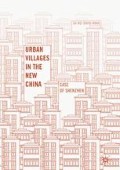Abstract
This chapter focuses on the history of urban villages. These places were once agrarian villages that, in spite of the stereotype, have a history of their own. The villages saw dynasties come and go. They saw wars and revolutions. Since the emergence of new China, they were communized and formed into work brigades. The political chaos in the late 1960s and 1970s forced many local villagers to flee to Hong Kong. Yet the villages remained. They urbanized themselves along with the new Shenzhen City.
Access this chapter
Tax calculation will be finalised at checkout
Purchases are for personal use only
Notes
- 1.
The legend of Mazu was popular along the Fujian coast. It told the story of a peasant girl named Lin Miaoniang who had the mythical power of foretelling weather and sailing conditions. According to folklore, she helped many sailors with her abilities. She was later declared a saint by local authorities. Today, the worship of Mazu is widespread among coastal communities of Chinese in China and Southeast Asia.
- 2.
All my original villager interviews were conducted by appointment. Interviewees are given a codename in capital letters, to protect their anonymity. To further protect their identity, their village name is also coded in capital letters.
- 3.
The sijiu (four old things) are old Customs, Culture, Habits, and Ideas.
- 4.
The Ox and Snake demons were political symbols of remaining capitalist and feudal reactionary elements in Chinese society. ‘Da daoniuguisheshen’ (‘Defeat the ox and snake demons’) was a common political slogan during the Cultural Revolution.
- 5.
This is a term referring to the whole generation of educated urban youth were sent to the rural areas and frontiers by Chairman Mao to work and learn from the peasants.
Bibliography
Baoan Annals Editorial Committee 1997 (eds), Baoan Annals, Guangdong Renmin Chubanshe, Shaoguan. (in Chinese)
Gong, T 1998, Zhengyi Yu Qishi—Yuangeng Zai Shekou Ji Shi, China Youth Publishing, Beijing. (in Chinese)
Guo, X (ed.) 2001, Shenzhen Wenshi, Vol. 7. Haitian Publishing, Shenzhen. (in Chinese)
Ho, P 2000, ‘Contesting Rural Spaces: Land Disputes, Customary Tenure and the State’, in Chinese Society: Change, Conflict and Resistance, eds E Perry and M Sheldon, Routledge, New York.
Huang, S (ed.) 2008, Nine Chapters of Shenzhen: a Historical Record of the Opening-Up, A Mirror of China’s Reform, Huacheng Chubanshe, Guangzhou.
Irwin, L 1990, ‘Divinity and Salvation: The Great Goddesses of China’, Asian Folklore Studies, vol. 49, no. 1, pp. 53–68. Available from: JSTOR [18 September 2009].
Jin, X 2010, Shenzhen Transition:Revolution in Urban Governance Model, Haitian Chubanshe, Shenzhen.
Lawinfochina.com 2013, Land Administration Law of People’s Republic of China. Available from: http://www.lawinfochina.com/display.aspx?lib=law&id=3673&CGid= [12 March 2013].
Li, J 2007, China:Challenge of Rapid Urbanization, China Construction Industrial Publishing, Beijing.
Li, P, 2004, The End of the Village: The Story of Yang Cheng Village, The Commerical Press, Beijing.
Peng, S 2009, ‘Luo Hu Villages in 60 Year –the Case of Luofang Cun’, Shenzhen Wanbao, 10/09/2009, p AII2. (in Chinese)
Scott, J 1998, Seeing Like a State: How Certain Schemes to Improve the Human Condition Have Failed, Yale University Press, New Haven.
Shenzhen Archive 2005 (eds), Shenzhen Dangan Wenxian Yanyi, Huacheng Publishing, Guangzhou. (in Chinese)
Shenzhen Museum 2008, Ancient Shenzhen, Shenzhen Museum, Shenzhen. (in Chinese)
Shenzhen Municipal Government 1986, ‘A Notice on Further Planning of Shenzhen SEZ’s Agrarian Villages’, Shenzhen Municipal Government Document, no. 411, Shenzhen. (in Chinese)
Shenzhen Municipal Government 1989, ‘Rules on Land Acquisition Within Shenzhen Special Economic Zone’, Shenzhen Municipal Government Document no.7, Shenzhen Municipal Government, Shenzhen. (in Chinese)
So, D, 1998, Teaching Language & Culture: Building Hong Kong on Education, Longman, Hong Kong.
Xie, XN 2010, ‘A City: Written Full of Hope and Chasing Dream for 30 Years’, Southern Metropolis Daily 1 March, p. AII 08–09.
Tucker, R 1978, The Marx –Engel Reader, W.W. Norton & Co, London.
Xiao, T 2010, Lineage Politics: Analysis of Power Network in Village Governance, Shangwuyingshuguan, Beijing.
Yiftachel, O 2009, ‘Theoretical Notes on ‘Gray Cities’: The Coming of Urban Apartheid?’, Planning Theory, vol. 8, no. 1, pp. 88–101. Available from: Sage Journal Online [15 October 2012].
Author information
Authors and Affiliations
Copyright information
© 2016 The Author(s)
About this chapter
Cite this chapter
Wang, D.W.D. (2016). The Villages and Shenzhen City: History, Transition, and Coexistence. In: Urban Villages in the New China. Palgrave Macmillan, New York. https://doi.org/10.1057/978-1-137-50426-5_3
Download citation
DOI: https://doi.org/10.1057/978-1-137-50426-5_3
Published:
Publisher Name: Palgrave Macmillan, New York
Print ISBN: 978-1-137-50425-8
Online ISBN: 978-1-137-50426-5
eBook Packages: Social SciencesSocial Sciences (R0)

